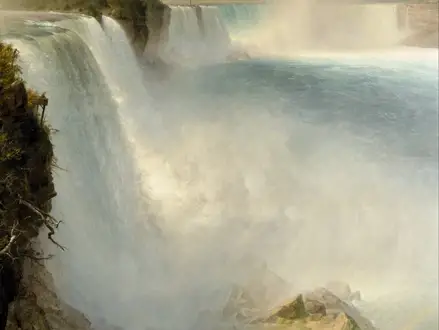Title of Artwork: “Niagara Falls, from the American Side”

Artwork by Frederic Edwin Church
Year Created 1867
Summary of Niagara Falls, from the American Side
One of the best examples of Church’s work in the high Sublime style, which developed in the late eighteenth century with JMW Turner and others, may be seen in this enormous picture. Church may have believed that the most effective instrument at his disposal to convey to his audience the vastness of his subject matter was size. Since it’s more than 2.5 metres tall, the spectator is seated on a cliff face at the falls’ mouth, with their eyes pulled down and across the vertigo-inducing depths shown with vertigo-inducing realism.
All About Niagara Falls, from the American Side
It was the job of the Sublime in art to envelop the audience in a sensation of immensity that was at once inspirational and scary, and to temporarily lift them out of their bodies. In this painting, Church wanted to recreate the awe-inspiring nature of the Falls by allowing his viewers to feel the spray of mist, hear the rushing water, and see the cascade in action. In this way, the horizon’s neglected line is significant, engulfing the viewer’s attention in a raging torrent.
Since the 1850s, Church had visited and painted Niagara Falls, doing oil drawings on trips in 1857 and 1858. During one of these trips, Niagara (1857), a full-scale painting, is horizontally positioned, emphasising the rush of water toward and over the brink. Church switches his attention to the enormous cloud of spray at the bottom of the falls in this later piece. At the middle of the painting is a thick and opaque mass of the spray, which suggests an educated conversation between comprehensive description and allusion and emotive environment in Church. As a matter of fact, this work appears to refute the critique of his contemporaries, John Ruskin, who remarked dismissively that “[Church] can draw clouds as few men can, though he does not know yet what painting means, and I suppose he never will.”
Information Citations
En.wikipedia.org, https://en.wikipedia.org/.























